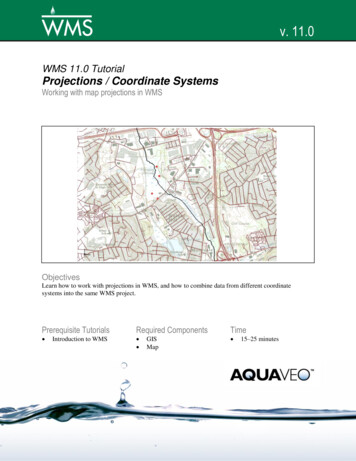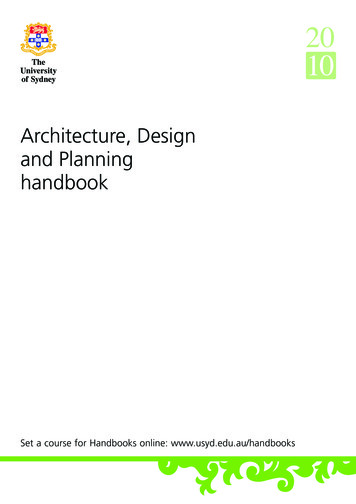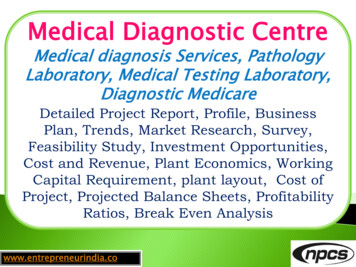
Transcription
REAL CentreProjectionsNHS workforceprojections 2022Report July 2022Nihar Shembavnekar, James Buchan,Nuha Bazeer, Elaine Kelly, Jake Beech,Anita Charlesworth, Ruth McConkey,Rebecca Fisher
About the REAL CentreThe Health Foundation’s REAL Centre (research and economic analysis for the longterm) provides independent analysis and research to support better long-termdecision making in health and social care.Its aim is to help health and social care leaders and policymakers look beyond theshort term to understand the implications of their funding and resourcing decisionsover the next 10–15 years. The Centre will work in partnership with leadingexperts and academics to research and model the future demand for care, and theworkforce and other resources needed to respond.The Centre supports the Health Foundation's aim to create a more sustainablehealth and care system that better meets people’s needs now and in the future.NHS workforce projections 2022is published by The Health Foundation,8 Salisbury Square, London, EC4Y 8APISBN: 978-1-911615-74-3 2022 The Health Foundation
ContentsAcknowledgments2Executive summary31. Introduction122. The state of the NHS workforce and the impact ofCOVID-19173. P rojections of the overall gap between workforcedemand and supply524. Nurse supply projections575. General practice workforce supply projections646. Implications76References86
AcknowledgmentsThe authors gratefully acknowledge input and guidance provided by severalstakeholders, including NHS England and NHS Improvement, NHS Digital, theDepartment of Health and Social Care, Health Education England, NHS Providers,NHS Employers, the General Medical Council, the Nursing and MidwiferyCouncil, HM Treasury, the Royal College of Nursing, the Royal College ofGeneral Practitioners, the British Medical Association, the Chartered Society ofPhysiotherapy, the Council of Deans of Health and the Queen’s Nursing Institute.Further, the authors are grateful for background information provided by WilliamPalmer and Nina Hemmings from the Nuffield Trust in supporting discussions.The authors are also grateful for constructive peer review feedback provided by thefollowing individuals: Miqdad Asaria (REAL Centre Visiting Fellow and Assistant Professor,Department of Health Policy, London School of Economics andPolitical Science) Jane Ball (Professor of Nursing Workforce Policy, University of Southampton) Amanda Hensman-Crook (Health Education England) Rachel Newton (Head of Policy, Chartered Society of Physiotherapy) Abigail Henderson (Head of FCP implementation, Chartered Societyof Physiotherapy) Beccy Baird (Senior Fellow in Health Policy, The King’s Fund).In addition, the authors would like to thank REAL Centre and wider HealthFoundation colleagues for their input, support and guidance, with particularthanks to: Jennifer Dixon, Giulia Boccarini and George Stevenson, who reviewedthe report Stephen Rocks, Laurie Rachet-Jacquet, Claudia Barclay, Charles Tallack andToby Watt for helpful discussions and input members of the Health Foundation communications team: Sean Agass, KateAddison, Pete Stilwell, Frances Kirk, Creina Lilburne and Tatjana Cvijanovic.Errors and omissions remain the responsibility of the authors alone.When referencing this publication please use the following URL:https://doi.org/10.37829/HF-2022-RC012NHS workforce projections 2022
Executive summaryWorkforce shortages represented the single biggest challenge facing the NHSand adult social care in England well before COVID-19. But the pandemic hasdriven increased demand for health care, growing waiting lists and a substantialelective care backlog, while impacting negatively on staff wellbeing and absence.This makes workforce planning all the more urgent for recovery, both from a staffrecruitment, retention and wellbeing perspective, particularly in light of ongoingcost-of-living pressures, and in terms of patient safety and satisfaction.This report provides the REAL Centre’s projections of future NHS workforce supply– the number of staff likely to be in post – and demand, the number of staff likelyto be required. Both are crucial for comprehensive long-term workforce planningand wider resource planning. In our analysis, a gap between projected workforcesupply and demand indicates that the NHS is unlikely to be able to deliver 2018/19standards of health care using existing care models.At an overarching level, our supply and demand projections cover the whole of theNHS Hospital and Community Health Service (HCHS) sector and general practiceworkforce in England. Our in-depth analysis focuses on two staff groups: registerednurses (across all sectors but focusing on the HCHS), and GPs and other patientcare staff working in general practices and primary care networks (PCNs). Togetherthese groups account for nearly 3 in 10 of the 1.4 million full-time equivalent (FTE)NHS staff in England.Nursing and general practice have consistently been afflicted by staff shortages andhigh workload pressures over the past decade. In this report we present differentscenarios based on varying assumptions to project the future supply and demandof registered nurses and patient care staff in general practice. These are projectionsrather than forecasts: we build on available data to hypothesise how futureworkforce gaps might evolve, while acknowledging the uncertainties inherent in ourassumptions. This report explores the levers that policymakers could focus on tomitigate these gaps in workforce.On the workforce supply side, long training pathways for clinical staff and changesin service models, workforce composition (the skill mix) and working patternsover time all mean that health care workforce planning requires a comprehensivelonger term focus. Regular assessments of NHS workforce supply-demand gapswill be indispensable in order to close those gaps within a specified timeframe. Thisreport aims to foster greater urgency and focus in this area and cautions againstcontinued policy short-termism.Executive summary3
ScenariosTo estimate how many NHS staff are likely to be needed in future years (workforcedemand), we project the future health care activity needed to keep up withunderlying demand pressures, driven by demographic and morbidity changes.Our analysis also accounts for additional pressures on future health care activity,including additional funding linked to NHS Long Term Plan commitments and theadditional activity needed to clear the elective care backlog by 2028/29. We focuson a workforce demand scenario that assumes there are some productivity gainsin the acute hospital sector from reductions in the average length of stay and afurther shift to day case activity, but that the rate of change is less than over thepast decade.Our detailed analysis of the future supply of registered nurses, GPs and otherpatient care staff in general practice is built around three scenarios:*1.The ‘current policy’ scenario assumes that workforce numbers increase inline with current trends and policies already being implemented to promotestaff recruitment and retention.2.The ‘optimistic’ scenario assumes that workforce numbers increase morerapidly than in the ‘current policy’ scenario, with sustained policy action andits effective implementation closing existing workforce gaps over the decadeto 2030/31.3.The ‘pessimistic’ scenario assumes that workforce numbers grow moreslowly relative to the ‘current policy’ scenario or even decline, driven by alack of additional policy action and workforce planning, or failure of currentpolicy action, particularly beyond 2023/24. It envisions a ‘worst case’ world inwhich the risks posed by COVID-19 to NHS staff recruitment and retention notonly materialise but significantly exacerbate existing shortfalls.Our projectionsOverall NHS workforce supply and demandOur high-level analysis points to an overall workforce supply-demand gap ofaround 103,000 FTE across the NHS HCHS and general practice, accounting forboth clinical and non-clinical staff,† in England in 2021/22 (around 7% of estimatedFTE workforce demand). To deliver 2018/19 standards of NHS care and accountingfor current workforce supply trends and NHS Long Term Plan commitments,*See Chapter 4, Chapter 5, Annex C and Annex E for a full breakdown of scenario assumptions.†These high-level projections account for all FTE clinical and non-clinical staff in the NHS HCHS andgeneral practice, except GP trainees and locums.4NHS workforce projections 2022
this gap is projected to increase to around 180,000 FTE by 2024/25 beforedeclining gradually to a still substantial 160,000 FTE in 2030/31 (around 9% ofprojected demand).There are two reasons why this estimate of a workforce gap of 160,000 FTE by theend of the decade is considerably lower than corresponding estimates in previouswork. First, we have updated our workforce demand projections to account forpotential future reductions in hospital staff time per patient as a result of furtherfalls in the average length of hospital stay and more treatments provided on a daycase basis. Second, we use updated workforce supply data to 2021/22, whereasin previous work we used data up to 2018/19 only. Over the past 3 years NHSworkforce numbers have increased at a faster rate than over the previous decade(as discussed in section 3.2).Registered nursesRegistered nurses are indispensable to health and social care provision. Around370,000 registered nurses work in the HCHS, general practice, adult social care andindependent health care providers in England. The NHS HCHS employs over 4 in5 (around 85%) of this active registered nurse workforce and there are better dataavailable for HCHS nurses relative to other sectors.Even before the pandemic, this group represented the most pressing area of NHSworkforce shortfall. In the HCHS workforce, FTE registered nurses accountedfor around 2 out of every 5 vacancies in England between April–June 2017 andOctober–December 2021, even though they account for just over 1 in 4 staff. Theregistered nurse vacancy rate indicates that about 1 in 10 funded FTE NHS HCHSregistered nurse posts was unfilled at any point. The impact of the pandemic on thenurse workforce is still unfolding, but emerging evidence of workload pressuresand burnout points to substantial retention risks. In the medium term, there is alsouncertainty around the impacts on student nurse registration and recruitment (seeChapter 4).Our nurse supply projections, obtained using the REAL Centre nurse supplymodel,* are summarised in Table 1 and Figure 1. In our short-term projections, thedifference between nurse supply in 2020/21 and 2023/24 is relatively small in allscenarios. However, in the longer term projections, significant differences emergebetween the three scenarios, highlighting the importance of taking a longer termview. Under current policy, our projections show that the NHS HCHS is likely to facea shortage of 50,600 FTE nurses in 2023/24 and shortages will continue for the restof this decade, with a shortfall of 30,300 FTE nurses by 2030/31.*Cave S, Woodham E, Derbyshire K, Lewis S, Wildblood R, Shembavnekar N. Nurse supply model:overview. The Health Foundation; 2021 -overview).Executive summary5
Table 1: Potential FTE nurse supply and demand in the NHS HCHS inEngland, nd gap,2023/242030/31Projectedsupplydemand gap,2030/31Demand350,700369,000Supply: Current y: pply: 2%412,900Projected average(compound)annual growthrate, 2021/22–2030/311.8%Source: REAL Centre analysis based on the nurse supply model (using a range of data sources). Numbers are rounded.Figure 1: Potential FTE nurse supply and demand shortfall in the NHS HCHS inEngland, 2021/22–2030/31Estimated shortfall of FTEregistered nurses, NHS HCHSCurrent 0,0002021/222023/242030/31Source: REAL Centre analysis based on the nurse supply model (using a range of data sources).Note: Numbers are rounded. The slight differences in the estimated shortfall of FTE registered nurses across the threescenarios in 2021/22 arise because 2020/21 data currently represent the final full year of workforce data incorporated inthe REAL Centre nurse supply model (so that 2021/22 nurse supply estimates are projections and vary slightly acrossthe three scenarios). In the optimistic scenario, we project a shortfall in nurse supply in 2023/24 but supply potentiallyexceeding demand in 2030/31 (this explains the negative shortfall projection in that scenario).Progress towards the 50,000 nurses targetIn its 2019 manifesto the government set a target of recruiting 50,000 additionalFTE registered nurses in the NHS HCHS and general practice in England by the endof the current parliament. This implies increasing the number of FTE registerednurses in the NHS from around 301,000 in September 2019 to around 351,000 byMarch 2024. The government appears to be on track to meet the target, largelythrough continuing substantial increases in international recruitment, on the back6NHS workforce projections 2022
of record recent increases in the number of nurses trained in non-European Union(EU)/European Economic Area (EEA) countries newly registering with the Nursingand Midwifery Council (NMC). However, our analysis suggests that the 50,000target is not sufficient to address the projected demand for registered nurses andmeeting it would still leave the NHS facing a shortage of around 38,000 FTE HCHSand general practice nurses relative to projected demand in 2023/24.Patient care staff in general practiceGeneral practice in England covers around 149,000 FTE staff (as of December2021) working across practices and PCNs. It comprises four key staff groups:GPs (accounting for roughly a quarter – 24% – of general practice staff), nurses(another 11%), other direct patient care (DPC) staff (around 16%) and administrativeand non-clinical staff (around 49%). General practice is increasingly taking theform of multidisciplinary teams, with a rapid expansion of roles including clinicalpharmacists, physiotherapists and social prescribing link workers over the past 2years. Staff numbers in these three roles more than quadrupled between December2019 and December 2021.Building on previous research,* we used publicly available NHS Digital and HealthEducation England (HEE) data to assess how future numbers of fully qualified,permanently employed GPs,† nurses and other DPC staff in general practice arelikely to change in the decade to 2030/31.Our projections of the GP supply-demand gap to 2030/31 are presented in Table 2and Figure 2. As it takes at least a decade to train a fully qualified GP, the substantialdifference between the projected GP shortfall in 2030/31 in the optimistic andpessimistic scenarios is largely driven by varying assumptions regarding GP leaverrates and the expansion and integration of DPC staff groups in general practice overthe rest of this decade. It is worth emphasising that in the optimistic and pessimisticscenarios, the projected GP shortfall in 2023/24 is slightly higher than in the currentpolicy scenario. This reflects the potential for increased supervisory responsibilityfor newer roles combining with existing workload pressures to temporarily ratchetup GP demand.In the optimistic scenario, with sustained policy support and effective integrationof newer general practice staff roles in the medium term, the GP shortfall can becontained to around 3,300 FTE by 2030/31. Conversely, the lack of policy actionand inadequate support for integration and longer term planning embodied inthe pessimistic scenario results in a projected GP shortfall that is around six timeslarger by 2030/31 (around 20,400 FTE).*Undertaken by the Health Foundation in collaboration with The King’s Fund and the Nuffield Trust:Beech J, Bottery S, Charlesworth A, Evans H, Gershlick B, Hemmings N, Imison C, Kahtan P, McKennaH, Murray R, Palmer B. Closing the gap: key areas for action on the health and care workforce; g-the-gap).†Unless stated otherwise, all projections refer to FTE numbers and we focus on fully qualified, permanentlyemployed GPs (all GPs excluding GPs in training and locum GPs).Executive summary7
Table 2: FTE demand and supply estimates and projections for qualifiedpermanent GPs in England, 2021/22–2030/31Current policy scenarioOptimistic scenarioPessimistic scenarioGP demandGP supplyGP demandGP supplyGP demandGP 3,30019,400-20,400Source: Authors’ analysis based on data from NHS Digital and Health Education England.Note: The numbers in the table are rounded and refer to FTE qualified permanent GPs (ie all GPs excluding GPs in trainingand locum GPs); 2021/22 GP supply data are for March 2022 (source: NHS Digital).Note: The shortfall is calculated as the difference between GP supply and demand. Due to rounding, the shortfallestimates presented in the table do not all align precisely with the differences between GP supply and demand in thecorresponding cells.Figure 2: Potential FTE GP supply and demand shortfall in the NHS in England,2020/21–2030/31*Estimated shortage of qualifiedpermanent FTE GPs*Current 05,00002021/222023/242030/31Source: REAL Centre analysis based on NHS Digital and HEE data.*This refers to qualified permanent GPs (all GPs excluding GPs in training and locum GPs). Note: Numbers are rounded.The scale of the projected GP shortfall is substantial. Under current policy, weproject that by 2030/31 the NHS would have around 27,100 qualified, permanentFTE GPs, around 10,700 less than we project would be needed – a shortfall of over1 in 4 GP posts. In all three scenarios, we also project that there will be a persistingshortage in the number of FTE general practice nurses over the decade to 2030/31.8NHS workforce projections 2022
Progress towards government targetsIn its 2019 manifesto the government set a target of recruiting 6,000 additionalFTE GPs (including GP trainees and locums)* and 26,000 additional FTE patientcare staff other than GPs and nurses in specified general practice roles in Englandby 2023/24. In all of our scenarios, we project that the 6,000 GP target will notbe met. Under current policy, we project that the total number of FTE GPs mightbe around 3,000 more in 2023/24 relative to 2018/19, but the number of qualifiedpermanent FTE GPs will have fallen, so any overall increase will be attributableto higher numbers of GP trainees and locums. The data and evidence so far onwhether the government’s other target will be met, of recruiting 26,000 additionalFTE professionals in Additional Roles Reimbursement Scheme (ARRS)-fundedDPC roles in general practice, are unclear. However, accounting for rapid increasesin recruitment to these roles in the past 2 years, our modelling assumes thatthis target is met in the current policy and optimistic scenarios, but not in thepessimistic scenario.Table 3 summarises our estimates of the supply-demand gap for registered nursesand patient care staff in general practice in the current policy scenario in 2021/22and 2030/31.Table 3: Potential FTE supply and demand, registered nurses (NHS HCHSand general practice), qualified permanent GPs and other DPC staff ingeneral practice in the NHS in England in the current policy scenario,2021/22–2030/31Supply, Estimated Estimated Supply, Estimated2021/22 demand, supply2023/24 demand,2021/22demand2023/24gap,2021/22Estimated Supply, Estimatedsupply2030/31 andgap,2030/31Registered nursesin the NHS HCHSand generalpractice322,800 369,000-46,200334,900 388,700-53,700398,300 435,000-36,700Qualifiedpermanent 0-10,700Other DPC staff ingeneral practice(excluding GPsand *Source: REAL Centre analysis based on the nurse supply model and NHS workforce data from NHS Digital and HealthEducation England. As the numbers in the table are rounded, estimates of the workforce supply-demand gap may notprecisely match the corresponding supply and demand figures.* The estimate for registered nurses in the NHS HCHS and general practice is a projection under the 'current policy'scenario, derived from the REAL Centre nurse supply model. This differs from our estimate of the projected nurse supplydemand shortfall in 2023/24 if the government's 50,000 NHS nurses target is met, which is around 38,000 FTE nurses.**As discussed in section 5.3.3, we do not estimate the future demand for other DPC staff in general practice.*Our projections in this report, however, focus on the number of fully qualified, permanently employedGPs (all GPs excluding GP trainees and locums).Executive summary9
ImplicationsOur report underscores five key workforce planning themes (see Chapter 6 forfuller analysis):1.Addressing NHS workforce shortages requires comprehensive long-termplanning and acknowledgement that improvement will take many years.2.‘Top-down’ targets are unlikely to be effective in addressing workforcesupply-demand shortfalls. Policymakers should account for geographic andsector variation in workforce supply and demand.3.Workforce policies need to be fully costed and funded to be implementedeffectively.4.Joined-up policymaking needs to be underpinned by substantive research onthe drivers of workforce supply and demand as well as rigorous projectionsanalysis.5.The gaps in accessible data for the NHS workforce that this reportunderscores should be acknowledged and mitigated. This dovetails with therecent findings of the Goldacre Review on the lifesaving potential of qualityhealth data provision.Our projections also have wider systemic implications for the NHS: At around 103,000 FTE, the scale of the estimated overall NHS workforcesupply-demand gap in 2021/22 was substantial. Even if we assume thatfuture increases in the demand for NHS staff can be partially containedthrough a reduction in average staff time per patient over the comingdecade, the supply-demand gap is projected to grow to around 160,000FTE by 2030/31 (around 9% of projected staff demand). This suggests thatexisting NHS care models will not be able to deliver 2018/19 standards ofcare through the coming decade without compromising on quality, safety,productivity and staff wellbeing. The government appears to be on track to meet its 50,000 nurses target by2023/24, largely through sustained substantial increases in internationalnurse recruitment. However, this would still leave the NHS short of around38,000 FTE HCHS and general practice nurses relative to projected demandin 2023/24. In the current policy scenario, the NHS is projected to face apersisting supply-demand shortfall of around 36,700 FTE nurses in 2030/31.In our optimistic scenario, concerted policy action aimed at improving nurseretention and domestic training numbers can bridge this gap in the NHSHCHS – but not for general practice nurse numbers – by 2030/31. This report raises significant questions about general practice workforcesupply. In all scenarios, we project a persistent shortfall of FTE GPs andgeneral practice nurses. In the pessimistic case, the GP supply-demand gapgrows to around 20,400 FTE by 2030/31 – effectively 1 in 2 GP posts based10NHS workforce projections 2022
on projected demand. Containing this gap to around 3,300 FTE (1 in 10projected GP posts) – our optimistic scenario – will require the effectiveimplementation of policies aimed at boosting NHS GP retention rates overthe coming decade. Equally, it will hinge on how substantially the potentialof more multidisciplinary general practice teams is realised in the latter halfof the decade.ConclusionThis report lays bare the scale of the challenge facing policymakers in addressingendemic NHS workforce shortages. Registered nurses and patient care staffin general practice have been core parts of the fight against COVID-19 and willcontinue to play a vital role in the recovery. But against a backdrop of alreadysubstantial workload pressures, burnout, funding constraints and a cost-of-livingcrisis, policy action is urgently needed to support improvements in NHS staffrecruitment and retention.NHS workforce planning has been beset by short-termism and a preference forexpediency over requirement. There is no ‘silver bullet’ solution to England’sworkforce shortages. But this report adds to a growing body of evidence that pointsto the need for a comprehensive long-term workforce strategy. Long-term planningwill, by definition, bear fruit over the next few years, but it has never seemed morepressing than at present.Executive summary11
1.Introduction1.1 ContextThe past 2 years have understandably been dominated by the urgent response toCOVID-19. But while the pandemic hit all sectors of the economy hard, its impacton the health and social care workforce has been particularly substantial – not leastbecause these workforces entered the pandemic under severe pressure. In fact,workforce shortages are widely seen to be the biggest single challenge facing bothsectors in England.1Between 2010/11 and 2018/19, growth in NHS staff numbers in England was wellbelow estimated increases in activity levels.1 Much of the NHS workforce alsoexperienced real-terms decreases in pay during this period.2 Against this backdrop,the commitment and dedication displayed by the NHS and social care workforceover the course of the pandemic are all the more striking.Existing workforce pressures are underpinned by a lack of comprehensivelong-term workforce planning, particularly the absence of regularly publishedand independently verified projections of workforce supply.3 Such projections areindispensable for any assessment of whether current trends in workforce supplywould be sufficient to meet projected demand without imposing unrealistic orunsustainable workforce productivity targets; what it would take to close the gap ifthere are projected shortfalls; and whether there are particular areas of the healthservice where future workforce shortages appear the most likely or acute.The urgency of such an assessment is underlined by 2021/22 NHS Staff Surveyresults that provide evidence of increasing proportions of staff experiencingworkload pressures and considering leaving their roles relative to pre-pandemiclevels.4 In a recent NHS Providers survey, most trust leaders (97–98%) reportedthat staff shortages were having a serious and detrimental impact on services andwould hinder progress in tackling growing backlogs.5This report builds on and extends the projections and recommendations made in2019’s Closing the gap.6 This featured future registered nurse* and GP supply anddemand projections to 2028/29. It made a number of policy recommendationsthat were subsequently reflected in the government’s introduction of cost-of-livinggrants for degree-level nursing, midwifery and many allied health students in 20207and the shift towards more multidisciplinary general practice staff teams.8 Closingthe gap also emphasised the NHS Long Term Plan ambition to ‘ensure a sustainable*Where this report uses the word ‘nurse’, it refers to registered nurses.12NHS workforce projections 2022
overall balance between supply and demand across all staff groups’.9 This is allthe more significant given the unintended consequences and hidden costs ofNHS staffing shortages, including additional spending on agency staff, lowerproductivity and system inefficiency.This report highlights the risks posed by growing NHS workforce shortages tothe ability of the NHS to deliver pre-pandemic standards of care, calling for policyaction and regular, longer term workforce planning. While there is relatively littleevidence on how workforce undersupply affects health service delivery,10 onerecent study points to a direct link between registered nurse vacancy rates andpatient safety in hospitals.11Workforce planning is also inextricably linked with NHS funding choices andpressures. While the NHS did not suffer to the same degree as other areas ofpublic spending from the past decade of austerity,12 it did not receive the fundingneeded to meet growing demand pressures.13,* In 2021, the Health Foundation’sREAL Centre projected that to maintain 2018/19 rates of care, the NHS wouldrequire real-terms funding increases of 3.2% to 3.5% a year on average over the2018/19–2030/31 period.12 This amounts to between 63bn and 72bn in additionalannual funding in 2030/31 relative to 2018/19 (in 2021/22 prices). With permanentand bank staff spending accounting for just under half of the NHS’s revenueexpenditure (44% in 2020/21),14 the size and composition of the future NHSworkforce are key to any consideration of long-term service sustainability.The government has acknowledged the workforce planning gap and hascommissioned NHS England to develop a workforce plan.14 However, it is vitalthat planners initiate further policies to address longstanding workforce shortagesacross the NHS and social care. The absence of a long-term focus, coupled with thefact that investments in health care staff training, recruitment and retention can takeyears to bear fruit, strengthen the need for regular projections of future workforcesupply and demand.In this report, we present high-level supply and demand projections for the NHSHospital and Community Health Service (HCHS) workforce in England, followedby detailed projections for two key ‘workforce pressure points’: registered nurses(across all
The state of the NHS workforce and the impact of COVID-19 17 3. Projections of the overall gap between workforce . Jane Ball (Professor of Nursing Workforce Policy, University of Southampton) . the supply of training places (including university and college, nursing associate and apprenticeship opportunities).33










